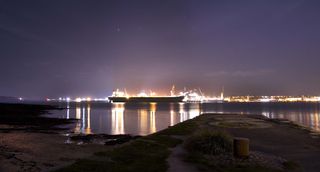Streetlights Lure Beasts of the Tiny Kind

Beware streetlights: A new study finds that well-lit areas of cities and towns are more likely to be home to predators and scavengers.
Luckily for humans, these predators and scavengers are of the invertebrate variety, including predator beetles and other insects. The study is the first to find that light pollution is changing ecosystems as a whole, not just individual organism behavior.
"Despite artificial lighting being commonplace for many decades now, we really haven't got to grips with how it may be affecting the environment," said study researcher Thomas Davies, a community ecologist at the University of Exeter in the U.K.
Researchers have previously found that light pollution can attract some invertebrates, making them more vulnerable to predators, Davies said. Light pollution can also mess with certain insects' daily routines. Fireflies, for example, have trouble finding mates when it's too bright.
Davies and his colleagues wanted to take a broad look at the tiny ecosystems living around well-lit streets. They placed invertebrate traps in bright and unlit areas in the city of Helston in the U.K. for three days and three nights in August 2011. These traps collected 1,194 creepy-crawlies. [Gallery: World's Cutest Bugs]
A count of these buggy specimens revealed that more predators and scavengers gathered in well-lit spots under streetlights. This was true both day and night, meaning that it wasn't just the lights attracting these invertebrates at night — they had moved in around the clock.
Specifically, well-lit areas harbored more ants, more harvestmen (sometimes called "daddy longlegs"), more woodlice (or roly-polies), which are mostly detritivores that devour dead stuff, and more amphipods, an order of scavenging crustaceans that look much like fleas. (Various species of ants and harvestmen can be either scavengers or predators.)
Sign up for the Live Science daily newsletter now
Get the world’s most fascinating discoveries delivered straight to your inbox.
The plants in dim and bright areas were similar, meaning that the light was having a direct effect on these invertebrates rather than changing the environment in general.
The results of the study are preliminary, Davies told LiveScience, and researchers aren't sure why predators and scavengers would be drawn toward the light. It's possible that some species find well-lit areas to be better hunting grounds, he said.
Nor is it clear whether humans should be switching off or dimming our streetlights, Davies said. Currently, artificial lighting is growing at a rate of about 6 percent annually worldwide.
"Further research is required to ascertain whether we should be concerned," he said. But invertebrates are crucial for both pollination and decomposition, he added.
"We need to get a better idea of how street lighting is affecting these ecosystem services," Davies said.
The researchers reported their findings today (May 22) in the journal Biology Letters.
You can follow LiveScience senior writer Stephanie Pappas on Twitter @sipappas. Follow LiveScience for the latest in science news and discoveries on Twitter @livescience and on Facebook.

Stephanie Pappas is a contributing writer for Live Science, covering topics ranging from geoscience to archaeology to the human brain and behavior. She was previously a senior writer for Live Science but is now a freelancer based in Denver, Colorado, and regularly contributes to Scientific American and The Monitor, the monthly magazine of the American Psychological Association. Stephanie received a bachelor's degree in psychology from the University of South Carolina and a graduate certificate in science communication from the University of California, Santa Cruz.
